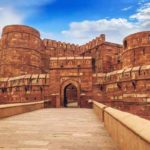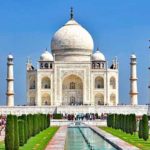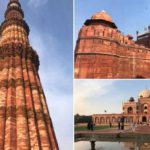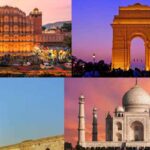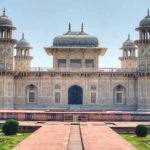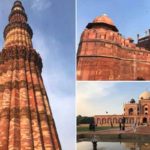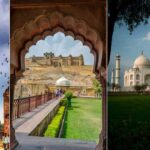Red Fort Delhi, which is also known as the Lal Qila, was constructed by one of the most famous Mughal emperors, Shah Jahan. Built on the banks of river Yamuna, the fortress-palace was designed by architect Ustad Ahmad Lahauri. It took 8 years and 10 months to build the magnificent fort. The fort served as the royal residence of the Mughal emperors from 1648 to 1857. It took over the honor of royal residence from the famous Agra Fort when Shah Jahan decided to shift his capital from Agra to Delhi.
The Red Fort derives its name from the red-sandstone walls, which make the fort almost impregnable. The fort, which is located at Old Delhi, is one of the massive and prominent structures of India and is a fine example of Mughal architecture. It is often considered as the pinnacle of Mughal creativity. In modern times, the fort is of importance to the people of India as the Indian Prime Minister delivers his Independence Day speech from the fort, every year on August 15. In 2007, it was declared as UNESCO World Heritage Site.
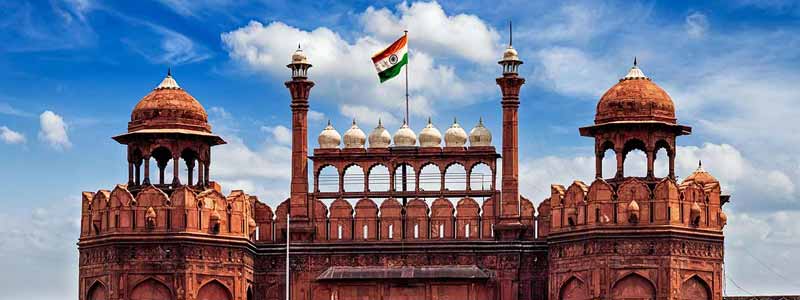
Interesting Facts on Red Fort
- Lal Qila is full of afternoon stories and its legends make for an interesting cosy chat. There is one which talks about how the prisoners were beheaded and used as a foundation of the building for good luck.
- There lies a hidden ‘baoli’ or stepwell touted to be older than the Red Fort Delhi which remains inaccessible to visitors even today.
- It was said that one could fish from the fort back in the day when it was built on the western banks of the Yamuna but then the river changed its course over the years.
- The British destroyed the green belt inside the fortress to build barracks for the colonial army.
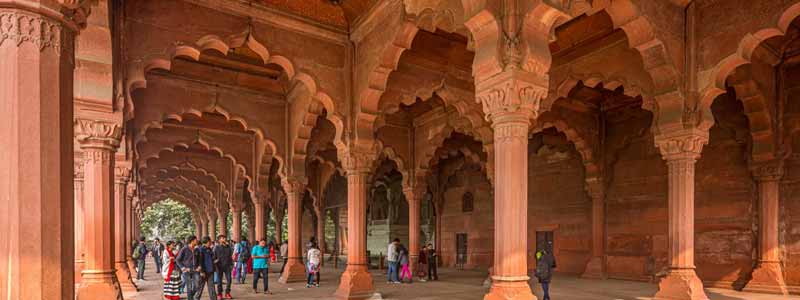
History of Red Fort
The construction of Red Fort Delhi began in the holy month of Muharram, on 13 May 1638. It took nine years to build, and under the supervision of Shahjahan, the Fort was completed on 6 April 1648. To contain the older Salimgarh Fort inside its boundaries, the walls were built asymmetrical, unlike any other Mughal buildings Delhi Tour Packages.
It remained the seat of Imperial Mughal Rule till 1857 when the Great Revolt took place. It consists of several other structures which were built during Shah Jahan’s life, and some which were added by the later rulers. His son and successor Aurangzeb, added the Pearl Mosque or the Moti Masjid to the fort complex when he took over as the emperor after a fierce War of succession between him and his three brothers.
The Fort saw its degradation after the Aurungzeb rule was over. In 1712, another ruler Farrukhsiyar replaced silver ceiling with copper. In 1739, the Persian Emperor Nadir Shah invaded Delhi and looted the Red Fort, taking away with himself the precious Peacock throne. The Fort was captured, plundered and attacked several times between 1739 and 1857 by Ahmad Shah, Marathas, Sikhs and the British. To raise funds for the defence of armies from Ahmad Shah Durrani, Marathas sold the silver ceiling of Diwan-e-Khas in 1760.
The Fort was the seat of Mughals for 200 years, but after the revolt of 1857, the last Mughal emperor, Bahadur Shah II was exiled to Rangoon. He was the last Mughal resident of the Fort and the symbol of 1857 rebellion against the British in which Shahjahanbad residents participated. This marked the end of the Mughals.
The fort was then occupied by the British Colonial Rulers, who invaded a lot of precious artifacts such as the Kohinoor diamond, the Jade Wine Cup of Shah Jahan and the crown of Bahadur Shah II. They planned a systematic destruction of the Fort which included destroying of furniture, gardens, harem apartments and servant quarters. Except for the white marble buildings, almost all of the inner structure was destroyed. Later in 1899, when Lord Curzon became the Viceroy of India, he ordered reconstruction of the building and gardens were also restored.
After the British left India, the first Prime Minister, Jawahar Lal Nehru raised the National Flag from Lahori Gate and since then, every Independence and Republic day witnesses the Prime Minister unfurling the National Flag and giving his ceremonial speech at the Red Fort Delhi.
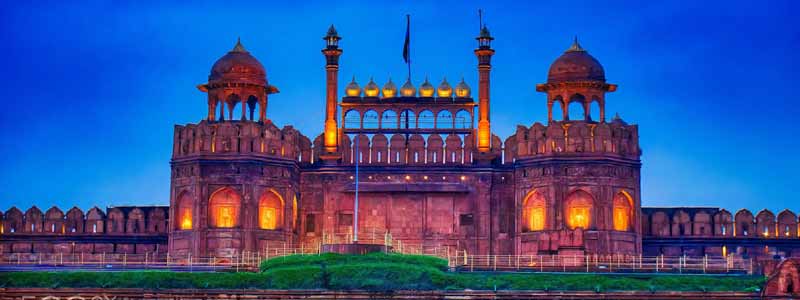
Architecture of Red Fort
Combining features of Indian, Persian and Timurid forms of architecture, the Red Fort Delhi is truly a monument par excellence. The architect of the Red Fort was Ustad Ahmad Lahauri, who also designed the Taj Mahal. It is surrounded by a 2 km perimeter wall which acted as an effective defensive measure. The structure of the fort is octagonal, and it has several gates, the prominent ones being Lahori, Ajmeri, Kashmiri, Mori, Turkman and Delhi gates.
The Red Fort Delhi houses several structures inside its premises. The most well known among all these are the Diwan-i-Aam, the Diwan-i-Khaas, the Moti Masjid and the Nahr-i-Bashisht (stream of paradise).
The ‘Diwan-i-Am’ also known as ‘Hall of Public Audience’ is a rectangular hall consisting of three aisles, with a façade of nine arches. Originally there were six marble palaces along the eastern water front. A water-channel, called the Nahr-i-Bihisht (‘Stream of Paradise’) runs through it, with an ivory fountain fitted with a central marble basin. The Mumtaz-Mahal now houses the Delhi Fort Museum. The Diwan-i-Khas (‘Hall of Private Audience’) is a beautifully decorated pillared hall, with a flat ceiling supported by engrailed arches. Peacock Throne is said to be kept here before being taken away by Nadir Shah.
The Hammam (‘Bath’) consists of three prime sections divided by corridors. The complete interior and the floor is built of marble and inlaid with coloured stones. Moti-Masjid (‘Pearl Mosque’) which was added later by Aurangzeb is to the west of the Hamman. The red-stone pavilion in the middle of the tank in the centre of the Hayat-Bakhsh-Bagh is called Zafar-Mahal and was built by Bahadur Shah II in about 1842.
Most of these buildings were inlaid with precious stones and intricate floral motives. The unique cusped arches, highly intricate ornamentation and the double domes are the most important features of the Red Fort’s architecture, something which became a trademark of Shahjahani architecture.
Timings of Red Fort Light & Sound Show
Red fort light and sound show timings are 7.30 PM to 8.30 PM for Hindi show. For show in English language, the timings are from 9 PM to 10 PM. This is from the month of May to August.
During the months of September and October, the timings for the show are 7 PM to 8 PM (Hindi) and 8.30 PM to 9.30 PM (English).
During the months November to January, timings are 6 PM to 7 PM (Hindi) and 7.30 PM to 8.30 PM (English) while from February to April it is from 7 PM to 8 PM (Hindi) and 8.30 PM to 9.30 PM (English).
Red Fort Light & Sound Show
One of the major attractions of Lal Qila Delhi is the light and sound show. The Red fort sound and light show is conducted in Hindi and English languages. Started in 1996, this show became immensely popular among visitors soon after its start. Here, the modern technologies are combined to present a peek into the historical grandeur of ancient India.
One of a kind, this show is around 1 hour long. The shows are organised in the evening, with an interval of one hour between them. As the shows starts, with the lighting and accompanying sound, Red Fort gains an impressive appearance. The emphasis is majorly on the history of the Mughal reign and its role in the construction of Red Fort.
Tickets for the light and sound show can be bought from the ticket booth at the Red Fort Delhi. Tickets are available till 1 hour before the show starts.
Places to visit near Red Fort:
Jama Masjid: Jama Masjid is situated right in the vicinity of the Red Fort Delhi. The mosque was also built by Shah Jahan in the 1650s. The place gives you an ideal flavor of how the traditional Old Delhi city was. The famous Jama Masjid is one of the most ancient and famous places of prayer for Muslims across the country.
Chandni Chowk: Chandni Chowk is the traditional marketplace that is dotted with stalls of handicrafts, furniture, clothes, dress materials, food, jewelry, souvenirs among other such things. The place is just a few blocks away from Red Fort. A visit to Delhi will remain incomplete if you don’t cover this shopping hub.
Swaminarayan Akshardham temple: The Akshardham temple is just 3.2km from the Red Fort. So you can hire an auto or get a cab to reach there. This is a very calm, serene, and fantastic place to visit with a great ambiance. The architecture of the temple is brilliant with white marble and broad corridors everywhere. The temple follows special security checking so be prepared to submit all your cell phones, cameras, etc. You can spend around two hours at the temple. This is an ideal place to visit with your family on weekends.
Gurdwara Bangla Sahib: This gurdwara on Ashoka Road is just 4km from the Red Fort Delhi. This is a must-see place in Delhi which is considered as the pious place for believers of the Sikh religion. The service of hundreds of volunteers here to the visitors and devotees is exemplary. A visit to the place brings you true peace and helps you connect with your inner self.
Raj Ghat: This is another must-visit place for all Delhi Tourism. Raj Ghat is where the mortal remains of the Father of the Nation Mahatma Gandhi was buried. The black marble platform burial in this open-air memorial site is beautiful with a nicely maintained garden that offers a calm and serene atmosphere. Maintaining silence is a must if you are a visitor here.
Fatehpuri Mosque: Fatehpuri Mosque is one of the most famous mosques and monuments of Delhi. It is located right in the vicinity of the Red Fort. It was built during the Mughal era. The mosque remains open every day from 5 am to 10 pm. On special occasions and festivals, the timings might change slightly. The place remains closed on Sundays. Visiting the mosque, which was built following the architectural pattern of the famous Fatehpur Sikri in Agra, will give the flavor of the old Delhi charm and the traditional Mughal culture. The mosque wears a grand look on Id and other such occasions.
Best Time To Visit
The Red Fort Delhi remains open in all seasons, every day from 9.30 am to 4.30 pm. However, it is difficult to roam around the fort if you visit Delhi during summertime. The scorching heat of the national capital is quite notorious and despite enough preventive measures, one might fall sick. Therefore, the best time to visit the place is anytime from October to February.
The weather this time remains pleasant. Neither do you need to carry warm clothes nor umbrellas to beat the sun. Overall it is a good time as the national capital is decked up owing to various festivals this time, especially Dussehra and Diwali.
How To Reach Red Fort
The nearest Metro Station is Chandini Chowk on the Yellow Line. You can hire an autorickshaw or a taxi from the metro station. Also, you can reach Red Fort Delhi from any part of the city through the DTC buses that ply regularly on this route.

